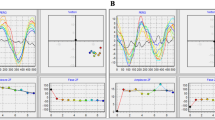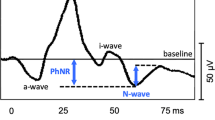Abstract
Background
Recording of the dark trough/light peak of the electrooculogram (EOG) remains a useful electrodiagnostic tool. Manual analysis of the recording is tedious and lengthy, and automated analysis needs to deal with artefacts due to suboptimal patient cooperation.
Methods
We present a novel method of automating the processing and analysis of raw EOG data using the open-source statistical software R. Rather than attempting saccade detection, we utilize the fact that basic properties of the response (rough waveform timing) are known and simply fit a square wave to each response run—free parameters are amplitude and phase. To assess this analysis method, responses from 54 eyes of 27 patients with a variety of ophthalmic diagnoses were analysed with manual calculation and with a number of automated methods of fitting the response curve. The Arden ratio was the main outcome measure.
Results
Robust regression of a fundamental with a three-harmonic approximation of a square wave was found to be the best method. Classification accuracy with this method compared with the manual calculations as gold standard; using a lower normal threshold of 200 %, Arden ratio was found to achieve a sensitivity of 96 % and specificity of 81 %. Time taken to process and analyse the data for a subject was reduced from 20 min for the manual method to 2 min for the automated method.
Conclusions
The simple approach yielded a surprisingly effective automatic estimation of the Arden ratio. In one author’s laboratory (MB), this procedure has proved to be useful over 5 years for routine analysis.












Similar content being viewed by others
References
Arden G, Barrada A, Kelsey J (1962) New clinical test of retinal function based upon the standing potential of the eye. Br J Ophthalmol 46(8):449–467
Marmor M, Brigell M, McCulloch D, Westall C, Bach M (2011) Iscev standard for clinical electro-oculography (2010 update). Doc Ophthalmol 122(1):1–7
Krämer F, White K, Pauleikhoff D, Gehrig A, Passmore L, Rivera A, Rudolph G, Kellner U, Andrassi M, Lorenz B, Rohrschneider K, Blankenagel A, Jurklies B, Schilling H, Schütt F, Holz FG, Weber BH (2000) Mutations in the vmd2 gene are associated with juvenile-onset vitelliform macular dystrophy (best disease) and adult vitelliform macular dystrophy but not age-related macular degeneration. Eur J Hum Genet 8(4):286–292
MacDonald IM, Gudiseva HV, Villanueva A, Greve M, Caruso R, Ayyagari R (2011) Phenotype and genotype of patients with autosomal recessive bestrophinopathy. Ophthalmic Genet 00:1–7
Kim E, Kim C, Lee J, Cho Y (2009) A case of primary intraocular lymphoma treated by intravitreal methotrexate. Korean J Ophthalmol 23(3):210
Mesquida M, Sanchez-Dalmau B, Ortiz-Perez S, Pelegrín L, Molina-Fernandez J, Figueras-Roca M, Casaroli-Marano R, Adán A (2010) Oxaliplatin-related ocular toxicity. Case Rep Oncol 3(3):423–427
Yen M, Wang A, Chiang S, Liu J (2000) Ethambutol retinal toxicity: an electrophysiologic study. J Formos Med Assoc 99:630–634
Bourne J, Hudak P, Duke J (1972) Computer automated electrooculography. Comput Biomed Res 5(6):654–658
Gosbell A, Barry W, Favilla I, Burkitt G (1991) Computer-assisted analysis of the electro-oculogram. Aust N Z J Ophthalmol 19(4):335–341
Riemslag F, Lunel H, Spekreijse H (1989) The electrooculogram: a refinement of the method. Doc Ophthalmol 73(4):369–375
Coughlin MJ (2002) Calibration of two dimensional saccadic electro-oculograms using artificial neural networks. Ph.D. thesis School of Applied Psychology, Griffith University, Queensland Australia
R Development Core Team (2012) R: A language and environment for statistical computing. R Foundation for Statistical Computing, Vienna, Austria. URL http://www.R-project.org/. ISBN 3-900051-07-0
Huber PJ (1973) Robust regression: asymptotics, conjectures and Monte Carlo. Ann Stat 1(5):799–821
Venables WN, Ripley BD (2002) Modern applied statistics with S, 4th edn. Springer, New York. URL http://www.stats.ox.ac.uk/pub/MASS4. ISBN 0-387-95457-0
Zou G (2007) Toward using confidence intervals to compare correlations. Psychol Methods 12(4):399
Martin Bland J, Altman D (1986) Statistical methods for assessing agreement between two methods of clinical measurement. Lancet 327(8476):307–310
Author information
Authors and Affiliations
Corresponding author
Rights and permissions
About this article
Cite this article
Sarossy, M.G., Lee, M.H.A. & Bach, M. A fast automated method for calculating the EOG Arden ratio. Doc Ophthalmol 128, 169–178 (2014). https://doi.org/10.1007/s10633-014-9430-5
Received:
Accepted:
Published:
Issue Date:
DOI: https://doi.org/10.1007/s10633-014-9430-5




